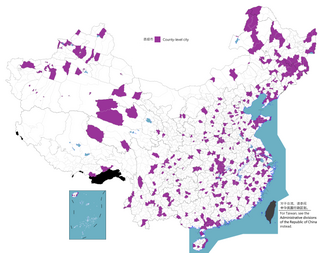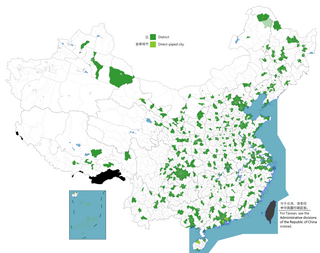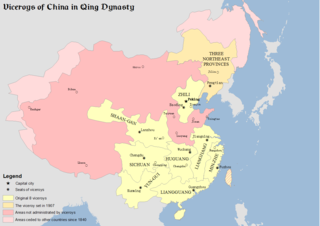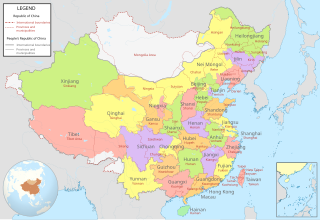 W
WAutonomous administrative divisions of China are specific areas associated with one or more ethnic minorities that are designated as autonomous within the People's Republic of China (PRC). These areas are recognized in the Constitution of China and are nominally given a number of rights not accorded to other administrative divisions. For example, Tibetan minorities in Autonomous regions are granted rights and support not given to the Han Chinese, such as fiscal and medical subsidies.
 W
WCounties, formally county-level divisions, are found in the third level of the administrative hierarchy in Provinces and Autonomous regions and the second level in municipalities and Hainan, a level that is known as "county level" and also contains autonomous counties, county-level cities, banners, autonomous banner and City districts. There are 1,355 counties in Mainland China out of a total of 2,851 county-level divisions.
 W
WA county-level municipality, county-level city or county city, formerly known as prefecture-controlled city, is a county-level administrative division of the People's Republic of China. County-level cities have judicial but no legislative rights over their own local law and are usually governed by prefecture-level divisions, but a few are governed directly by province-level divisions. Three of the claim county-level cities are part of the disputed Taiwan Province, but all of them are controlled by the Republic of China as its provincial cities.
 W
WA municipality, formally a municipality under the direct administration of central government, is the highest level of classification for cities used by the People's Republic of China. These cities have the same rank as provinces, and form part of the first tier of administrative divisions of China.
 W
WThe term district, in the context of China, is used to refer to several unrelated political divisions in both ancient and modern China.
 W
WGreater administrative areas were early top-level administrative divisions of the People's Republic of China that directly governed provinces and municipalities. These were the largest-ever political divisions of China and were controlled by the Central People's Government. They were dissolved between June and November 1954.
 W
WA league is an administrative unit of the autonomous region of Inner Mongolia in the People's Republic of China.
 W
WThis is a list of village-level divisions of the province of Shandong, People's Republic of China (PRC). After province, prefecture, county-level divisions, and township-level divisions, village-level divisions constitute the formal fifth-level administrative divisions of the PRC. There are a total of 1,858 such divisions in Shandong, divided into 500 subdistricts, 1,091 towns, 1 ethnic town, and 266 townships. This list is divided first into the prefecture-level cities then the county-level divisions then townshi-evel divisions.
 W
WThe Municipal Affairs Bureau of Macau is an administrative body without political powers responsible for providing certain civic services for the special administrative region and is the successor to the Civic and Municipal Affairs Bureau which was abolished in 2019. The latter was formed to handle the functions of the former municipalities of Macau and their councils and assemblies that were abolished on 1 January 2002, slightly more than two years after Macau became a special administrative region (SAR) of the People's Republic of China. The body is under the Secretariat for Administration and Justice of the Macau government.
 W
WMinzhe (闽浙) was an old geographic and political area of South-East China during Qing dynasty. It included Fujian, Taiwan province and Zhejiang province. The Governor of Minzhe was known as the viceroy of Minzhe in the English language. Its administrative centre was located in Fuzhou, Fujian province.
 W
WThe people's commune was the highest of three administrative levels in rural areas of the People's Republic of China during the period from 1958 to 1983 when they were replaced by townships. Communes, the largest collective units, were divided in turn into production brigades and production teams. The communes had governmental, political, and economic functions during the Cultural Revolution. The people's commune was commonly known for the collective activities within them, including labor and meal preparation, which allowed for workers to share local welfare.
 W
WPrefectures, formally a kind of prefecture-level divisions as a term in the context of China, are used to refer to several unrelated political divisions in both ancient and modern China. There are 333 prefecture-level divisions in China. They include 7 prefectures, 293 prefecture-level cities, 30 autonomous prefectures and 3 leagues. Other than provincial level divisions, prefectural level divisions are not mentioned in the Chinese constitution.
 W
WProvincial-level administrative divisions or first-level administrative divisions, are the highest-level Chinese administrative divisions. There are 34 such divisions claimed by the People's Republic of China, classified as 23 provinces, four municipalities, five autonomous regions, and two Special Administrative Regions. The political status of Taiwan Province along with a small fraction of Fujian Province remain in dispute, those are under separate rule by the Republic of China.